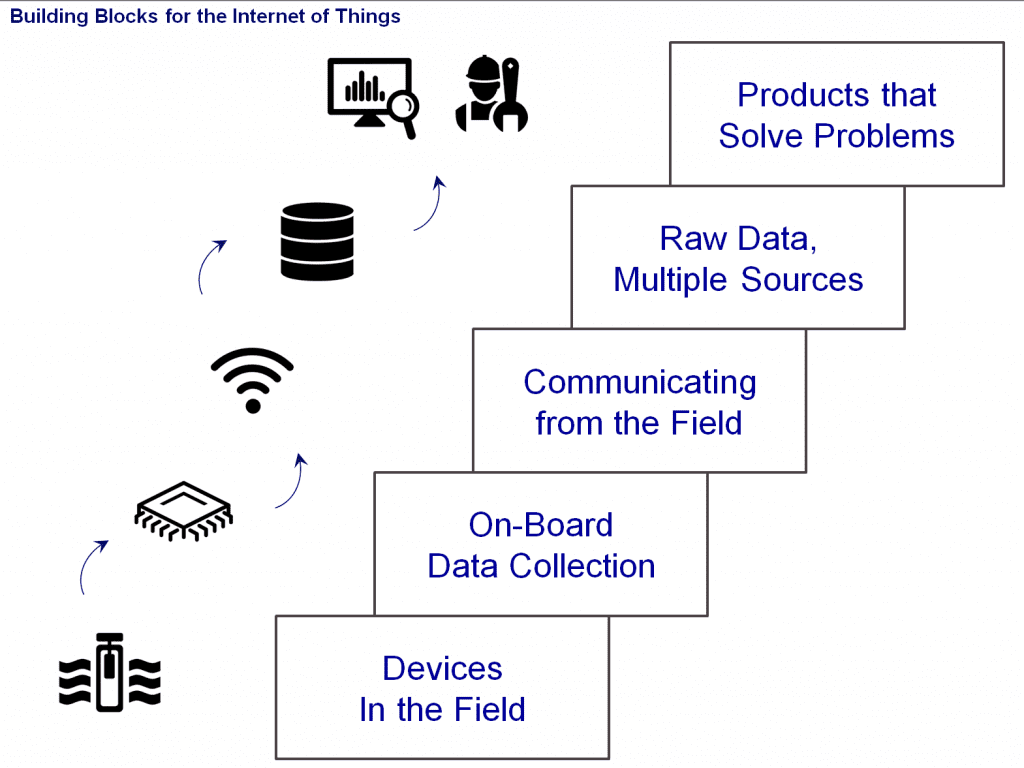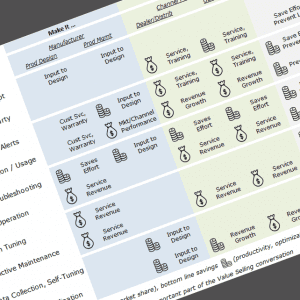Accelerate your IoT exploration with this simple framework for explaining the building blocks of IoT solutions; target the areas that present the biggest unknowns.
As we move beyond the hype stage for the Internet of Things (IoT), and start working with different businesses to identify and plan for real top line growth, there is a clear need to ground the conversations in the concrete and understandable. I’ll start the process by asking if they’ve ever heard of the “Internet of Things”, and I’m still not surprised when I’m greeted with blank stares or bemused expressions. However, when I list the common examples (typically, mentioning FitBit or Nest will do the trick) – the lights start to go on, we’re past the buzzword … but how does this impact my industrial customers and markets?
The challenge is that most of our IoT understanding is limited to these consumer product examples, gathering personal data and sharing it with, well, ourselves. It’s a bit of a leap to go from “heightened self-awareness” to industrial applications. Then again – a fair number of engineering and product marketing teams have been experimenting with skunkworks efforts, responding to customer requests, and dabbling in ideas for metrics that “kind of sound like that IoT stuff”. How can we identify and hook into that?
I’ve found it helpful to present a simple framework for IoT solutions, one that simplifies the exploratory conversation and breaks the ideas into easily understandable chunks. I carved out these “building blocks” in a purposeful manner – time and again, the dabblers have made progress in areas that they understand, but have come to an impasse on one of these five steps.

Are you interested in developing a new IoT product or service? Let’s start from the bottom:
Devices in the Field: There is data to be collected, but what kind of “thing” will you be deploying? Are we talking about adding a data component to an existing product, or developing an entirely new metering device?
On-Board Data Collection: We know what kind of data might be interesting – voltage, cycles, temperature, pressure, etc. But how exactly are we going to capture this information? What kind of measuring device, brilliant chip, or magic wire are we adding, and how will we sense the values that we need to record?
Communicating from the Field: Assuming we can collect the information – how are we going to send it to the “cloud”? Are we adding a cell phone to every pump (maybe) or every square yard of this farmer’s field (not likely)? How do we bridge that air gap?
Raw Data, Multiple Sources: And where exactly is this “cloud” we are sending stuff to – your development server in the back room, or a cloud-based virtual machine? And are we locked in a classic RDBMS mentality, or will we have to contemplate unstructured data? In high volumes? From global locations?
Products the Solve Problems: So let’s say we’ve picked the device, gathered the data, sent it up, and stored it in a database. Now what? Are we going to develop analytics and dashboards, or just sell subscriptions to the data? And how exactly are we going to monetize this – what is the value proposition?
Five different types of challenges, all of which can launch plenty of conversation and imaginative problem solving. I have used this framework to make lots of interesting progress …
- Some don’t know where to start; with the IoT Building Blocks, you can gravitate to your area of expertise and make concrete progress on something, just to start the ball rolling.
- Some don’t know where to focus; the IoT Building Blocks allow you to decompose the conversation and identify the biggest gap, so you can get right at the toughest challenge.
- Some already have solutions for a couple of the IoT Building Blocks, but never thought to extend their solution to become a real IoT offering. This approach will open there eyes a bit (one missing piece and … profit!)
- Sometimes Engineering has a great idea but can’t communicate the business case; the IoT Building Blocks help them tee up the potential product offering in a simpler way, so Marketing folks can understand the opportunity.
- Sometimes Marketing truly sees a great differentiator that is a response to the Voice of the Customer, but can’t communicate the technical need; the IoT Building Blocks help them quickly identify problem areas that Engineering will be able to target with a solution.
There are plenty of details to discuss in each of these areas (lack of standards, security concerns, fast-moving technology – just to name a few). This Framework is not meant to be the prescriptive path to take you from Idea to Riches … but it will help get the conversation past the Gee Whiz stage.
Icon credits from the Noun Project: Analysis, Mechanic, Database, Wifi, Microchip, Water Pump
17 September, 2014







This Post Has 0 Comments